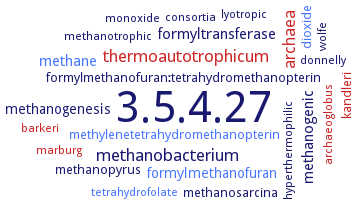3.5.4.27: methenyltetrahydromethanopterin cyclohydrolase
This is an abbreviated version!
For detailed information about methenyltetrahydromethanopterin cyclohydrolase, go to the full flat file.

Word Map on EC 3.5.4.27 
-
3.5.4.27
-
methanobacterium
-
thermoautotrophicum
-
archaea
-
methane
-
formyltransferase
-
methanogenic
-
formylmethanofuran
-
methanogenesis
-
methylenetetrahydromethanopterin
-
formylmethanofuran:tetrahydromethanopterin
-
dioxide
-
kandleri
-
methanosarcina
-
methanopyrus
-
methanotrophic
-
donnelly
-
marburg
-
wolfe
-
lyotropic
-
monoxide
-
hyperthermophilic
-
barkeri
-
archaeoglobus
-
consortia
-
tetrahydrofolate
- 3.5.4.27
-
methanobacterium
- thermoautotrophicum
- archaea
- methane
-
formyltransferase
-
methanogenic
- formylmethanofuran
-
methanogenesis
- methylenetetrahydromethanopterin
-
formylmethanofuran:tetrahydromethanopterin
- dioxide
- kandleri
-
methanosarcina
-
methanopyrus
-
methanotrophic
-
donnelly
- marburg
-
wolfe
-
lyotropic
-
monoxide
-
hyperthermophilic
- barkeri
- archaeoglobus
-
consortia
- tetrahydrofolate
Reaction
Synonyms
5,10-methenyltetrahydromethanopterin cyclohydrolase, CBH37751, cyclohydrolase, hydrolase, methenyltetrahydromethanopterin cyclo-, Mch, methenyl-H4MPT cyclohydrolase, methenyl-H4MPT+ cyclohydrolase, methenyltetrahydromethanopterin cyclohydrolase, N5,N10-methenyltetrahydromethanopterin cyclohydrolase
ECTree
Advanced search results
General Stability
General Stability on EC 3.5.4.27 - methenyltetrahydromethanopterin cyclohydrolase
Please wait a moment until all data is loaded. This message will disappear when all data is loaded.
addition of K2HPO4 or other salts prevents inactivation, relatively low concentrations of the salt, below 0.1 mM, are required for the stabilization, potassium salts being more effective than ammonium and sodium salts, at concentrations above 0.5 M, which are required for maximal activity the thermostability decreases again
-
at cyclic 2,3-diphosphoglycerate concentrations prevailing in the cells of Methanopyrus kandleri the enzyme is completely thermostable. At molar concentrations also the potassium salts of phosphate and of 2,3-bisphosphoglycerate, the biosynthetic precursor of cyclic 2,3-diphosphoglycerate confer thermostability to the enzymes
-


 results (
results ( results (
results ( top
top





